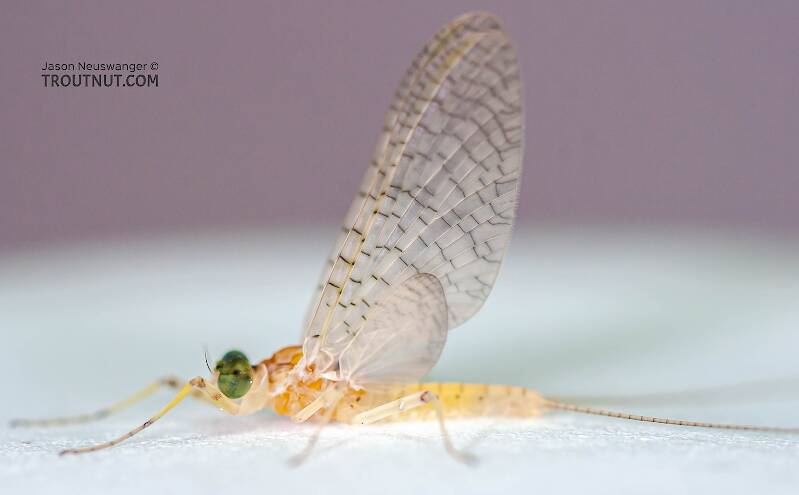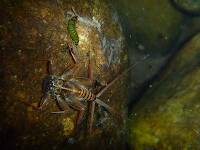
Salmonflies
Pteronarcys californica
The giant Salmonflies of the Western mountains are legendary for their proclivity to elicit consistent dry-fly action and ferocious strikes.
Featured on the forum

I was not fishing, but happened to be at an unrelated social event on a hill above this tiny creek (which I never even saw) when this stonefly flew by me. I assume it came from there. Some key characteristics are tricky to follow, but process of elimination ultimately led me to Sweltsa borealis. It is reassuringly similar to this specimen posted by Bob Newell years ago. It is also so strikingly similar to this nymph from the same river system that I'm comfortable identifying that nymph from this adult. I was especially pleased with the closeup photo of four mites parasitizing this one.

Troutnut is a project started in 2003 by salmonid ecologist Jason "Troutnut" Neuswanger to help anglers and
fly tyers unabashedly embrace the entomological side of the sport. Learn more about Troutnut or
support the project for an enhanced experience here.
GONZO on Nov 26, 2006November 26th, 2006, 6:02 am EST
Hi Jason-
While scanning the Stenacron specimens in response to Jeff's question, I came across this one. It does not appear to be Stenacron. It lacks the dark pigmentation (spot) between R1 and R2 that is distinctive of this genus. Clearly, it is a member of the Heptageniidae, but I haven't found a definitive clue to indicate which one it might be. Perhaps someone else will detect something more conclusive.
While scanning the Stenacron specimens in response to Jeff's question, I came across this one. It does not appear to be Stenacron. It lacks the dark pigmentation (spot) between R1 and R2 that is distinctive of this genus. Clearly, it is a member of the Heptageniidae, but I haven't found a definitive clue to indicate which one it might be. Perhaps someone else will detect something more conclusive.
Entoman on Feb 6, 2012February 6th, 2012, 12:20 pm EST
Somehow this one fell through the cracks. I agree with Gonzo this isn't Stenacron, and for the same reasons. It's also not Stenonema due to the lack of median posterior dark spots on the terga. The excellent ventral detail of the photo showing ridges on the prosturnum and the orientation of the furcasturnum clearly show it to be a member of the subfamily Heptageniinae. Due to eye separation and tarsi segment comparisons (among other characters) Maccaffertium male subimago from one of the spread eyed species is the likely choice.
This looks like Maccaffertium modestum, one of the Summer Cahills. Size isn't mentioned, but based on its proportions this specimen looks to be on the small side of the range scale for this species and fits well with the descriptions of the Midwestern rubrum form. Other species possibilities in this genus with which it could be confused are much larger. Tergal markings (spiracular dots, full length posterior dark lines), lack of crossvein crowding below the bullae, and the dark tail articulations are further positive characters. Together with matching color descriptions, relative abundance, and reported distribution in the specimen's locale, I think modestum is a reasonable opinion. ... The good news is this adds a more complete picture to the hatch page that was lacking a dun until now.
This looks like Maccaffertium modestum, one of the Summer Cahills. Size isn't mentioned, but based on its proportions this specimen looks to be on the small side of the range scale for this species and fits well with the descriptions of the Midwestern rubrum form. Other species possibilities in this genus with which it could be confused are much larger. Tergal markings (spiracular dots, full length posterior dark lines), lack of crossvein crowding below the bullae, and the dark tail articulations are further positive characters. Together with matching color descriptions, relative abundance, and reported distribution in the specimen's locale, I think modestum is a reasonable opinion. ... The good news is this adds a more complete picture to the hatch page that was lacking a dun until now.
"It's not that I find fishing so important, it's just that I find all other endeavors of Man equally unimportant... And not nearly as much fun!" Robert Traver, Anatomy of a Fisherman
Quick Reply
Related Discussions
Topic
Replies
Last Reply
3
Sep 4, 2012
by Entoman
by Entoman
13
Sep 14, 2011
by Jmd123
by Jmd123
11
Aug 29, 2011
by Entoman
by Entoman
8
Mar 30, 2012
by Brookyman
by Brookyman





